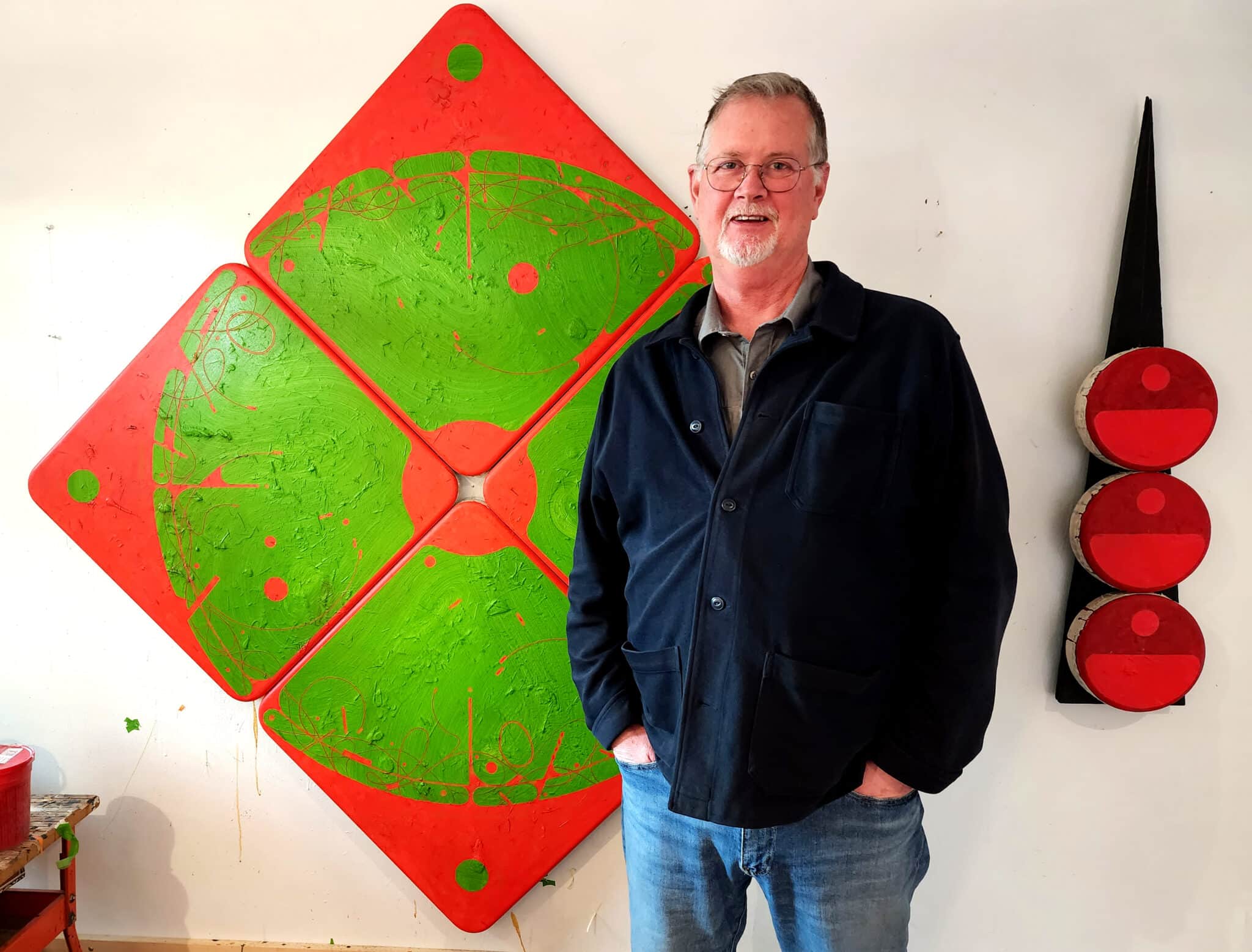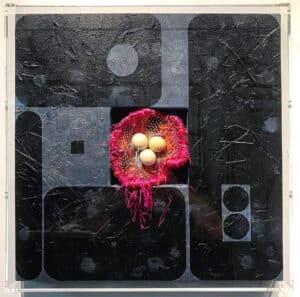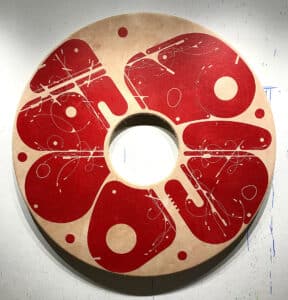
Shape Shifting: Painter Lee Hill approaches art with an architect’s eye
By Meda Kessler
As if being an architect isn’t enough of a challenge, Lee Hill also is an artist and a writer.
His three passions often intersect as he writes about architecture, and the way he paints is much like a building taking shape.
When he was young, Hill initially focused on art. He dabbled in painting as a high school student in West Texas, including creating scenic designs for the theater club. Hill was determined to hone his skills in college.
“I started out in the fine arts program at Texas Tech, but soon I realized that it wasn’t a good fit,” says Hill. “The college of architecture was next to the art school, and it always looked like the architecture students were doing much more interesting work and having fun. After my freshman year, I switched majors and loved it.”
Architecture consumed his time during college and after he graduated. “My wife and I married when I graduated in 1986. We didn’t want to stay in Lubbock, so I applied for an architecture job in Connecticut and got it. We lived near New York City, and I worked mainly on high-end coastal residences. For the next 11 years, I was so busy that I pretty much stopped painting.”
Both he and his wife missed Texas and moved to Fort Worth to be closer to family. It was Laurie, a physician assistant specializing in oncology, who jump-started her husband’s art career.
“One Christmas, she handed me a positive pregnancy test along with a box of art supplies,” says Hill. “She knew I missed painting and told me it was the perfect way to keep my mind busy and stay calm during her pregnancy.” Their son is now 22; they also have a 20-year-old daughter. Hill has been painting since then.

His studio is in a converted two-car garage of their 1950s home near TCU. A partial wall separates work space from storage, and it’s large enough to accommodate Hill’s larger abstract paintings. Dry paint splatters color the concrete floor, although the studio is tidy. A tour of the house reveals some of his earlier art, which is vastly different from his current style.
“A lot of my work then was bad, but it was good therapy. I had to figure out everything, from what kind of paints to work with to what I wanted to say with my work. Even in art school, I struggled with how little I knew.”
Hill is mainly self-taught but was open to inspiration by other contemporary painters and the world around him.
“In 2010, I went to Japan to study universal design. A visit to the Mori Art Museum in Tokyo changed the way I approached art and made me realize that I could combine architecture with my paintings.”
Hill began to focus on abstract patterns and experimented with using pinstriping tape to paint different shapes, an idea he picked up from working on model cars and watching videos.

It’s a method he continues to perfect. He found oil paints too smelly, so he opted for acrylic paint, mixing his own colors and zeroing in on specific brush styles. He makes his own wood panels and stretches the canvases to get the shapes he wants. He weathers the canvases by leaving them outdoors.
Close examination of Hill’s work shows layers of paint, with the pinstripe tape and natural materials, such as wild grasses, creating a dimensional effect. The shapes, none of them random, invite the eye to follow each line and curve, to examine the shadows and patterns.

Early in his career, he sought out like-minded creatives.
“I joined the Texas Artists Coalition, whose purpose is to support new and veteran artists, and sought out criticism and advice from people like gallery owner Bill Campbell,” says Hill. “TAC brought in professionals to review my work; Bill was blunt, but he gave me constructive advice and kept me in the game.”
Hill explored getting gallery representation and exhibiting his work, but that also was a struggle. “There was constant rejection, but you learn to stick with it.” He sent work to a Tulsa gallery, and a follow-up phone call with the owner resulted in Hill finally getting traction.

In Fort Worth, he briefly was represented by Fort Works Art, where he was the oldest artist. “Owner Lauren Saba did me a great favor by insisting I start an Instagram account,” says Hill. “It opened up a whole new world, connecting me with everyone from other artists to gallery owners around the world.”
Today, Hill’s social media videos and photos are insightful lessons on how he makes art.
While Hill was finally finding his footing in the art world, the pandemic was wreaking havoc on his architecture career. “Every project was canceled or postponed,” says Hill.
His unemployment was short-lived, as he joined Fort Worth-based VLK Architects as a senior associate in 2021. He joined the artist roster at Cufflink Art, a new gallery, in 2022. With the closing of Cufflink, he recently was picked up by William Campbell Gallery and makes his debut this month with “Semiosphere.” Hill says the term refers to a “space where signs, symbols and writings produce sense and experience, like a gallery space.”

Hill says his two careers — at some point he would like to be a full-time painter and maybe branch out into sculpture — are similar.
“I’ve always thought in patterns. The rugged Texas landscape is beautiful, but we impose buildings and roads on the landscape. My work reflects those two layers and how we make our marks on the land.”
THE DETAILS
William Campbell Gallery Lee Hill’s show, “Semiosphere,” is on display starting March 25, Spring Gallery Night, at William Campbell Gallery’s Foch Street location. (See more of his work at instagram.com/studioleealberthill.)
Also on exhibit is Rhode Island artist Lloyd Martin’s “Intonate Schemes.” Opening-night reception is 5-8 p.m. Both exhibits run through April 26.
Where: 217 Foch St., Fort Worth
Website: williamcampbellcontemporaryart.com
